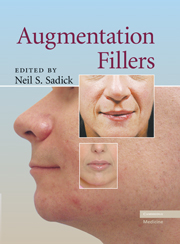Book contents
- Frontmatter
- Contents
- LIST OF CONTRIBUTORS
- Ch. 1 Application of Fillers
- Ch. 2 Approach to Choosing the Ideal Filler
- Ch. 3 Patient Selection, Counseling, and Informed Consent
- Ch. 4 Hyaluronic Acid Skin Derivatives
- Ch. 5 Collagen Products
- Ch. 6 Radiesse
- Ch. 7 ArteFill
- Ch. 8 Augmentation Fillers in Cosmetic Dermatology: Silicone
- Ch. 9 Advanta Expanded Polytetrafluoroethylene Implants
- Ch. 10 Sculptra
- Ch. 11 Lipo Transfer
- Ch. 12 BioAlcamid®
- Ch. 13 Combination of Approaches in Augmentation Fillers in Cosmetic Dermatology
- Ch. 14 Filling Complications
- Ch. 15 Postprocedure Management and Patient Instructions
- Ch. 16 Conclusion: Future Trends in Fillers
- INDEX
- References
Ch. 12 - BioAlcamid®
Published online by Cambridge University Press: 26 February 2010
- Frontmatter
- Contents
- LIST OF CONTRIBUTORS
- Ch. 1 Application of Fillers
- Ch. 2 Approach to Choosing the Ideal Filler
- Ch. 3 Patient Selection, Counseling, and Informed Consent
- Ch. 4 Hyaluronic Acid Skin Derivatives
- Ch. 5 Collagen Products
- Ch. 6 Radiesse
- Ch. 7 ArteFill
- Ch. 8 Augmentation Fillers in Cosmetic Dermatology: Silicone
- Ch. 9 Advanta Expanded Polytetrafluoroethylene Implants
- Ch. 10 Sculptra
- Ch. 11 Lipo Transfer
- Ch. 12 BioAlcamid®
- Ch. 13 Combination of Approaches in Augmentation Fillers in Cosmetic Dermatology
- Ch. 14 Filling Complications
- Ch. 15 Postprocedure Management and Patient Instructions
- Ch. 16 Conclusion: Future Trends in Fillers
- INDEX
- References
Summary
INTRODUCTION
A wide variety of synthetic fillers are now available. Such fillers can be divided into a variety of categories. One descriptive category relates to filler duration. Fillers can last in the human body for short periods of time or they can be permanent. BioAlcamid® is a permanent prosthesis-type filler. It is used in many parts of the world but is not yet available in the United States. An ideal biomaterial must be nonallergic, inert, sterile nonpyogenic, noncancer producing, stable, incapable of migrating, and most importantly biologically compatible with the host tissue. The latter factor is required because it impacts on the ability of the filler to coexist with surrounding tissues without either stimulating the immune system or causing persistent inflammatory reactions.
BIOALCAMID®
BioAlcamid®, a synthetic polyalkylamide manufactured by Polymekon in Italy, is a permanent implant that fulfills some, but certainly not all, of the aforementioned requirements.
CLINICAL STUDIES
There are only a few studies that have evaluated the safety and efficacy of BioAlcamid® implants. In a clinical study performed by Protopapa et al., eighty BioAlcamid® implants were injected into seventy-three subjects aged sixteen to forty-eight years (forty females and thirty-three males). All patients were HIV+ and suffered from lipodystrophy syndrome to varying degrees. Individuals with uncompromised diabetes mellitus and psychiatric disorders and pregnant women were excluded from the study. No prior skin tests were done. Initial implants were placed in the face. Ultimately, three patients requested further corrections to their buttocks; four patients requested corrections to their limbs.
- Type
- Chapter
- Information
- Augmentation Fillers , pp. 113 - 116Publisher: Cambridge University PressPrint publication year: 2010



